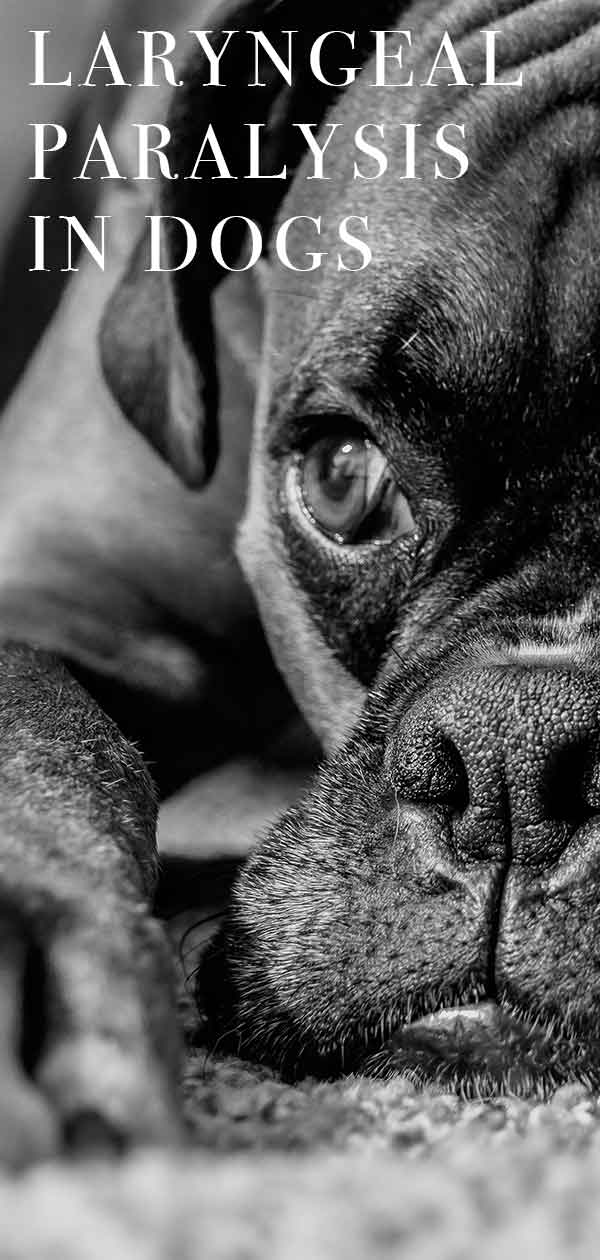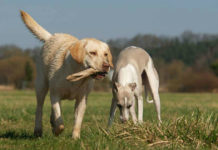As a dog owner, do you need to know about laryngeal paralysis in dogs?
The answer is yes, if:
- Your dog belongs to a medium or large-sized breed
- Your older dog breathes noisily
- The dog’s bark becomes altered
- Your dog pulls heavily on their collar
- You have a puppy that’s a Black Russian Terrier, Rottweiler, Dalmatian, Siberian Husky, Bouvier de Flanders, Leonberger, or Great Pyrenees
This is because the above are all risk factors for the condition, laryngeal paralysis in dogs.
What Is Laryngeal Paralysis in Dogs?
The larynx is the gateway to the windpipe (trachea).
When exercising, a healthy larynx opens wide to allow plenty of air to enter the lungs.
When eating, the larynx closes to prevent food and fluids going the wrong way, down into the chest.
Laryngeal paralysis in dogs occurs when the nerves controlling these movements are damaged.
This has two implications:
The entrance to the windpipe doesn’t fully open, restricting how much air the dog can breathe in
The larynx can’t close fully, which risks food passing down the windpipe to cause a form of pneumonia (inhalational pneumonia)
Laryngeal paralysis is most common in medium to large dogs over the age of 9 years.
But there is a rare, inherited form that affects young puppies from the breeds listed above.
Laryngeal Paralysis in Dogs: Symptoms
This condition is slowly progressive, so you more often see laryngeal paralysis in older dogs.
The earliest clue something may be wrong is a subtle change to the dog’s bark.
This is because the larynx is part of the dog’s voice box, and anything affecting this will change the dog’s voice.
Other signs include noisy breathing, almost as if the dog is hoarse.
As the condition gets worse, some dogs make a goose-honk sound as they breathe in and out.
The noises are worse when the dog exercises or the weather is hot.
Both of these require the dog to open their larynx fully to get extra air.
When the dog forces air in and out past the partially closed larynx, it makes the leading edges of the voice box vibrate.
This means the dog makes a visible extra effort to breathe, accompanied by a sound known as stridor.
Other Symptoms
The laryngeal paralysis in dogs symptoms to be alert for include:
- Noisy breathing
- Altered bark
- Breathing difficulties, especially in hot weather
- Shortness of breath leading to lack of energy
- A tendency to become overheated
- A goose-honk sound when excited
- Cough, fever, and lack of appetite (should aspiration pneumonia occur)
In the worst cases, other nerves are affected.
This can lead to other symptoms such as general weakness and difficulty swallowing.
If you notice any of these signs, be sure to get the dog checked by a vet.
The Causes of Canine Laryngeal Paralysis
Laryngeal paralysis in dogs is caused by nerve damage, so the deeper question is, “What causes the damage?”
In dogs, damage to the laryngeal nerve falls into three groups:
Older Dogs With General Nerve Degeneration
Older dogs from medium to large breeds are prone to old-age nerve degeneration.
This is particularly common in Labrador Retrievers, Great Danes, Brittany Spaniels, and Red Setters.
Puppies With a Hereditary Condition Affecting the Nerves
A faulty gene inherited from the parent dogs can cause juvenile canine laryngeal paralysis.
The at-risk breeds include Rottweilers, Dalmatians, Great Pyrenees, and the Black Russian Terrier.
Diseases Affecting the Laryngeal Nerve
The laryngeal nerve is the longest nerve in the body.
It runs from the throat and larynx, along the neck, and down into the chest.
Anything that presses on the nerve as it travels along this long route, or causes it to become inflamed, will alter how it works.
Common problems include trauma to the nerve, such as a dog that’s yanked on a choke chain.
Or a tumor growing within the confines of the chest can press on the laryngeal nerve, causing loss of function.
Other diseases that impact the laryngeal nerve include under-active thyroid glands (hypothyroidism), autoimmune diseases, and general inflammation as a result of other diseases.
Diagnosing Laryngeal Paralysis in Dogs
There’s a saying among vets that you can diagnose canine laryngeal paralysis with the patient still in the waiting room.
This is because of the characteristic goose honk noises when breathing.
To confirm this suspicion, the vet listens to the dog’s chest and larynx with a stethoscope.
When the noise is loudest in the throat, rather than the chest, the problem often lies with the larynx.
It’s necessary to rule out other problems that can cause breathing difficulties, such as infections and heart disease.
To do this, the vet will X-ray the dog’s chest to look at the heart size and hunt for tumors.
Then, with the dog under a light anesthesia, the vet will watch the laryngeal movements with an endoscope.
If laryngeal paralysis is confirmed, additional tests may be required to seek out any underlying causes, such as hypothyroidism.
Dog Laryngeal Paralysis Treatment
Once nerve damage has occurred, the effects are permanent.
Once the dog starts to struggle to breathe, then corrective surgery is the best option.
A procedure called a laryngeal tie-back holds the airway open so the dog breathes more easily.
This is a delicate procedure but, in the hands of a skilled surgeon, is highly successful.
Laryngeal Paralysis in Dogs: Non-Surgical Treatment
Medical treatment aims to switch off or correct whatever is damaging the nerve in the first place.
This might mean taking a thyroid hormone supplement (for hypothyroidism) or steroids (to switch off autoimmune disease).
All that extra effort to push air through a narrow larynx causes swelling of the soft tissue.
Drugs can reduce this secondary swelling around the airway.
Sometimes, the dog may panic when struggling to breathe, which only makes matters worse.
Then it may be necessary to prescribe sedatives to keep the dog calm and help them breathe.
Aspiration pneumonia is always a potential complication of laryngeal paralysis.
Antibiotics may be needed to control this.
How to Help a Dog with Laryngeal Paralysis
While there is no cure for laryngeal paralysis in dogs, you can help the dog to cope.
Strategies include using a harness, rather than a collar, so there is no pressure around the dog’s throat.
In hot weather, be proactive about keeping your pet cool, so they don’t need to pant as hard.
If the dog coughs a lot when eating, this is a sign they’re at risk of inhaling food.
In this case, hand-feeding the dog with meatballs is a good idea.
How Long Can a Dog Live With Laryngeal Paralysis?
Canine laryngeal paralysis slowly deteriorates over months and years.
Once the dog starts to struggle, then the tie-back procedure is advisable.
After this procedure, there is no reason why the dog can’t go on to live their full natural lifespan.
However, the tie-back does put the dog at increased risk of aspiration pneumonia.
Therefore, constant vigilance for cough, fever, and lack of energy are essential.
At the first sign of trouble, the dog should see the vet.
Special Cases of Laryngeal Paralysis in Dogs
Canine laryngeal paralysis is usually a disease of senior dogs, but sadly young puppies may also be affected.
A rare genetic trait is linked to juvenile canine laryngeal paralysis in Black Russian Terriers, Rottweilers, Siberian Huskies, and Dalmatians.
This also causes general muscular weakness, so affected puppies may have difficulty walking or swallowing.
Sadly, there is no treatment, and before these puppies reach six months of age, euthanasia is often required for humane reasons.
Prevention of Canine Laryngeal Paralysis
The biggest single way to help your dog is to use a harness rather than a collar.
This eliminates accidental damage to the laryngeal nerve when the dog pulls on the leash.
Otherwise, be vigilant, and see a vet at the first sign of breathing difficulties.
While nerve damage cannot be reversed, it can be stalled.
If the vet can identify an underlying cause, such as hypothyroidism, the damage can be limited.
Summary of Laryngeal Paralysis in Dogs
Laryngeal paralysis reduces the dog’s ability to breathe and increases the risk of pneumonia.
This condition is most common with increasing age in medium- to large-sized dog breeds.
While there is no cure for canine laryngeal paralysis, it is possible to improve quality of life with a surgical procedure called a laryngeal tie-back.
In addition, early identification and treatment of this problem may stop it getting worse.
References
Laryngeal Paralysis. Merck Veterinary Manual
Effect of vocal fold asymmetries on glottal flow. Laryngoscope. 2016 Nov; 126 (11): 2534-2538
Effects of thiopentone, propofol, and alfaxalone on laryngeal motion during oral laryngoscopy in health dog. Vet Anaesth Anal. 2017 May; 44(3): 427-434
Compound motor action potential duration and latency are markers of recurrent laryngeal nerve injury. Laryngoscope 2017 Aug;127 (8): 1855-1860
The Labrador Site Founder
Pippa Mattinson is the best selling author of The Happy Puppy Handbook, the Labrador Handbook, Choosing The Perfect Puppy, and Total Recall.
She is also the founder of the Gundog Trust and the Dogsnet Online Training Program
Pippa's online training courses were launched in 2019 and you can find the latest course dates on the Dogsnet website




















Can I use canned oxygen for my lab (13 years old) as a quick fix after I take him outside? I live in south Texas and its hot outside.